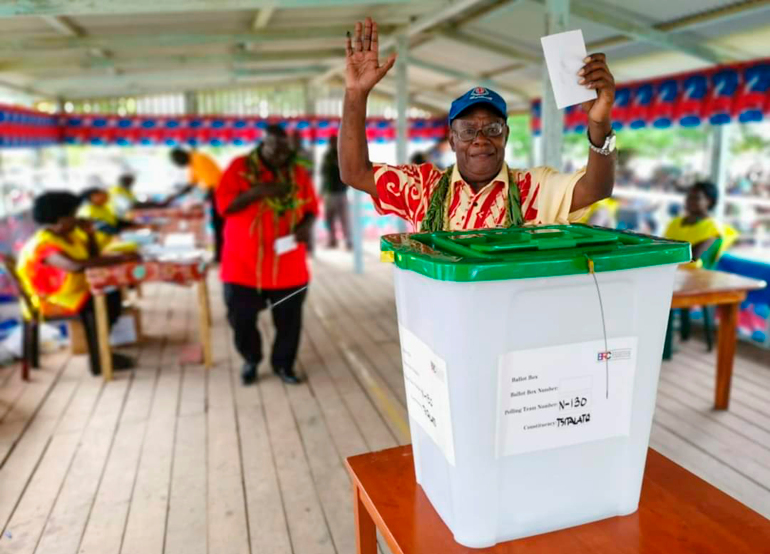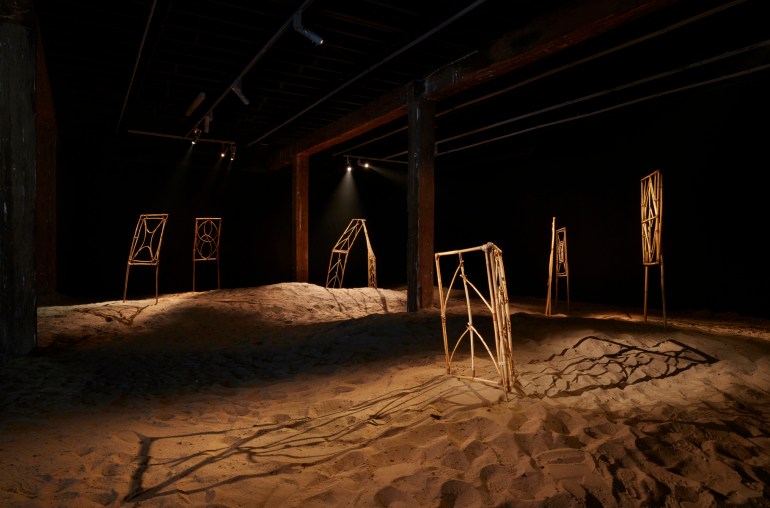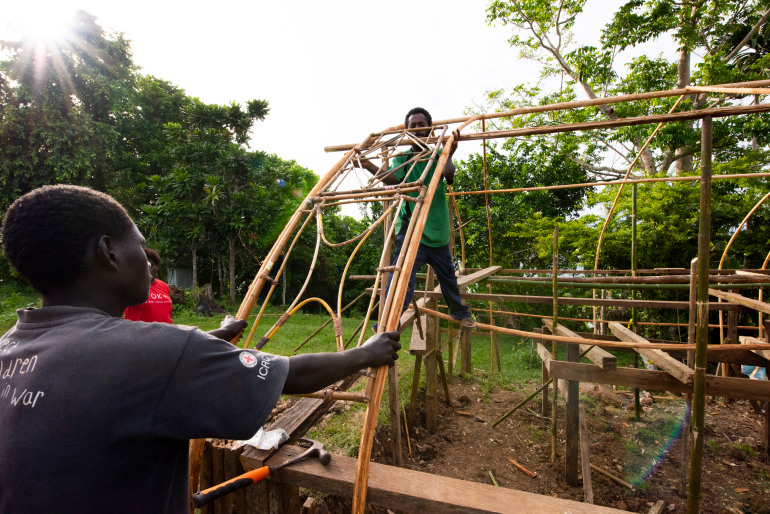The scene is epic, full of portent. A young woman clothed in white poses enigmatically in the photo’s foreground. Behind her is a vista of denuded mountain slopes and below, a blue pool of water at the bottom of a deep mining pit. Above, sombre grey clouds hang low. It is a picture of dark and light, foreboding and timelessness.
The photograph is the work of Taloi Havini, an artist from Bougainville in far eastern Papua New Guinea (PNG), who wants to draw the viewer into the history of her people and the extraordinary events which catapulted the remote Pacific island into the headlines 30 years ago.
In 1989, the Panguna copper mine, one of the world’s largest, located in the central mountains of Bougainville Island, became the centre of a David and Goliath struggle.
Outraged at the destruction of their traditional lands and inequity associated with the mine, Indigenous landowners rose up in arms against the majority owner, Rio Tinto, and the PNG government, its largest benefactors. The mining giant was forced to abandon the lucrative venture and the long civil war (1989-1998) which followed, while ending in triumph for the islanders, left deep human scars.
The photographic series, Blood Generation (2009), a collaboration between Havini, who was born eight years before war erupted, and award-winning Australian photographer, Stuart Miller, are powerful portraits of young people in Bougainville whose lives are profoundly affected by loss, but whose defiant poses also signal survival and resilience.
Nearly half of Bougainville’s population is under the age of 24 and many grew up without an education and in communities ravaged by conflict and uncertainty.
Havini’s family fled to Australia in 1990 where, as a young girl, her father, Moses, a prominent pro-independence advocate, gave her a cassette tape from a local Bougainville rock band.
“They had been making music under the military blockade and one of the songs was called Blood Generation. I used to listen to it and think about what my younger relatives were experiencing, how they couldn’t go to school but had to live under army control and how there was no contact with the outside world,” Havini told Al Jazeera. “Nineteen years later, it’s this generation whose vote contributed to the overwhelming response to full independence in the referendum last year.”
Historic vote
Bougainville, an autonomous region of about 300,000 people within PNG, has been back in the headlines over the past two years as the final stages of the 2001 peace agreement were implemented.
Last November, islanders voted overwhelmingly for independence in a referendum. Self-determination is a passionate issue, underlined this year when the region’s general election resulted in former rebel leader, Ishmael Toroama, being swept to power as Bougainville’s new president ahead of tough negotiations on the country’s future relationship with PNG.
For the artist, the political is also personal.
“Havini communicates and brings to the discussion table important and significant subjects that have impacted and continue to impact Bougainville and its people,” said Sana Balai, an Australian-based Pacific arts curator.
 People celebrate in the central Bougainville town of Arawa in 1998 after rebels and the Papua New Guinea government signed a permanent ceasefire to end nine years of conflict in the territory [File: Reuters]
People celebrate in the central Bougainville town of Arawa in 1998 after rebels and the Papua New Guinea government signed a permanent ceasefire to end nine years of conflict in the territory [File: Reuters] A man in Buka raises his hands as he prepares to vote in 2019’s historic referendum on independence from PNG [Post Courier via AP Photo]
A man in Buka raises his hands as he prepares to vote in 2019’s historic referendum on independence from PNG [Post Courier via AP Photo]
Havini was born in Arawa, a town situated less than an hour by road from the Panguna mine, although her father’s clan lives on Buka Island in northern Bougainville. Her mother, Marilyn, is Australian and Havini subsequently studied art in Australia and now exhibits around the world.
Earlier this year, her first Australian solo exhibition at Sydney’s Artspace included the artwork, Reclamation (2020), which covered the gallery floor in soil. On its undulating surface, dramatic lighting threw long shadows over sentinel-like cane sculptures.
“The primary installation consisted of a ‘taluhu’, traditional architecture (the local Hako word for shelter and protection). The main concept was to build from the earth a ‘bottom-up’ approach using natural temporal materials, such as cane and betel-nut palm that we often use to form an arch-like support frame,” Havini explained. “Reclamation was meant to honour the outcome of our struggle for self-determination and celebrate the historic arrival of the referendum for Bougainville’s independence.”
The work explores notions of “reclaiming” land and culture, in this context from foreign control, dating from German colonisation in the 19th century, the Australian administration early in the 20th century and rule by PNG after 1975. Behind this history of resistance is the deep bond between Melanesians and their customary land, which, above all else, is the source of life, and sustenance, and the home of their ancestors.
Connection to the land
In accordance with her culture, Havini created Reclamation in consultation with her clan.
“With support of my village, chiefs, mother and aunties, I created a space under my house … where we discussed art, our history and our culture by incorporating clan motifs and designs into the shelter and standing sculptures.”
 Reclamation, 2020, Materials Cane, wood, steel, soil. Artspace, Sydney. Courtesy of Taloi Havini [Photo: Zan Wimberley]
Reclamation, 2020, Materials Cane, wood, steel, soil. Artspace, Sydney. Courtesy of Taloi Havini [Photo: Zan Wimberley]
The tension between this world view and the profit-driven corporate mission to extract the region’s rich mineral resources, such as copper and gold, is an aspect of Havini’s multi-channel video installation, called Habitat (2018-2019).
It is a compelling work of moving images sourced from the national archives in Australia, news reporting of the civil war and Havini’s own family records, presenting local experiences of the Panguna mine’s controversial past.
“Because the Panguna mine threatened the existence of our healthy habitats, making vast areas uninhabitable due to toxic tailings and polluted freshwater river systems, the locals further protested and stopped the mine from operating after seeing all the wealth go to foreign interests,” Havini explained. “I was 10 years of age at the time, witnessing the tireless work of my activist parents who rallied at protests for international intervention for a peace process.”
Habitat also resonates with arts curator, Balai, who previously worked as an environmental analyst with Bougainville Copper, the mine’s operating company, and monitored the impact of the mine’s waste.
Her father worked with the government at the time, but like many other people in Bougainville, worried about being dispossessed where customary land is central to traditional Melanesian culture.
“Viewing Habitat, childhood memories of my father’s words came flooding back. When he returned home having witnessed protesting women or a woman chained herself to a machine, he held me tight and said through tears: ‘My daughter, I will never ever let anyone, especially outsiders take your land away from you and your sisters’,” she said.
 Reclamation, 2020 (Construction) Materials Cane, wood, steel, soil. Buka, Bougainville [Photo courtesy of Taloi Havini]
Reclamation, 2020 (Construction) Materials Cane, wood, steel, soil. Buka, Bougainville [Photo courtesy of Taloi Havini]
Most people in Bougainville believe nationhood is the only way they can fully own their islands and destiny.
However, last year’s referendum was non-binding and the region’s future will be decided following high-level national talks, expected to begin in 2021.
Edward Wolfers, Professor Emeritus of Politics at Australia’s University of Wollongong, believes that “the details and costs of Bougainville’s transition are likely to be particularly contentious for committed PNG nationalists, as well as supporters of a separate independence for Bougainville, and specialists concerned with the need for particular training, resources and expertise”.
With little internal revenue and ongoing post-conflict reconstruction, any political transition could take years. But President Toroama remains bullish. In his inaugural speech on September 29, he sought to rally the people of Bougainville.
“Independence has been our dream since the days of our forefathers,” he said. “We have fought for it and won the war, but we have not yet won the battle!”
Taloi Havini’s next major exhibition is The Soul Expanding Ocean #1: Taloi Havini, hosted by the art and ocean advocacy organisation, TBA21-Academy, at Ocean Space in Venice, Italy (20 March-17 October 2021)
 Habitat, 2018 – 2019. Materials: HD, colour, black & white, 5.1 surround sound, 10:33 mins Artspace, Sydney. Courtesy of Taloi Havini [Photo: Zan Wimberley]
Habitat, 2018 – 2019. Materials: HD, colour, black & white, 5.1 surround sound, 10:33 mins Artspace, Sydney. Courtesy of Taloi Havini [Photo: Zan Wimberley]





